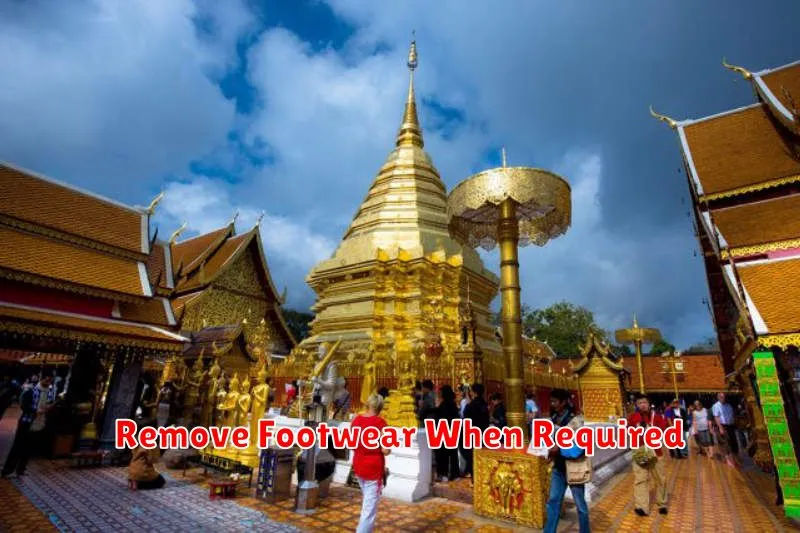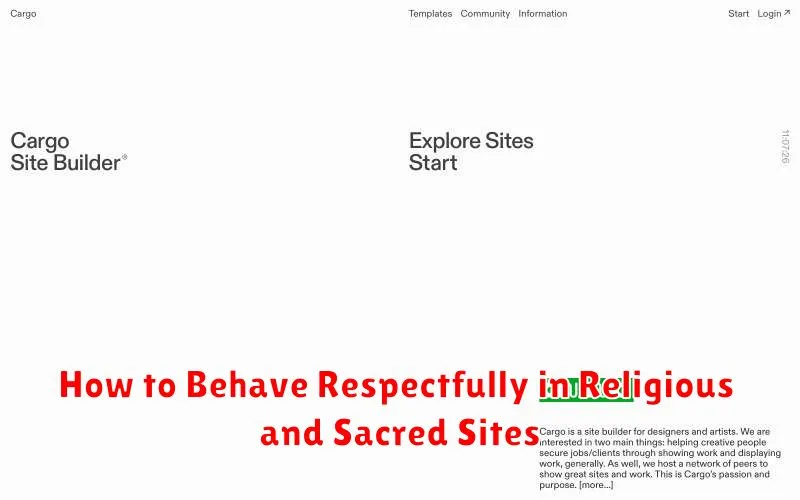Visiting religious and sacred sites offers a unique opportunity to connect with history, spirituality, and diverse cultures. Whether you are exploring ancient temples, grand cathedrals, serene mosques, or peaceful shrines, demonstrating respect is paramount. Understanding the etiquette and customs associated with these spaces ensures a meaningful and positive experience for yourself and others. This article provides essential guidelines on how to behave respectfully in religious and sacred sites, encompassing various faiths and traditions. By following these recommendations, you can contribute to the preservation of these important locations and foster respectful intercultural dialogue.
Demonstrating respect in religious and sacred sites involves more than simply being quiet. It requires a conscious effort to understand and adhere to specific customs, often rooted in deep-seated beliefs and traditions. From appropriate dress to photography guidelines and permissible behaviors, this guide will offer practical advice on navigating diverse religious and sacred spaces with respect and sensitivity. Learn how to be a respectful visitor and contribute positively to the preservation and appreciation of these culturally significant locations.
Why Respect Is Crucial at Sacred Sites
Sacred sites hold profound spiritual, cultural, and historical significance for individuals and communities. Demonstrating respect at these locations is not merely good manners, but an essential act of acknowledging this inherent value. These sites often serve as places of worship, contemplation, and connection to something larger than oneself.
Disrespectful behavior can cause offense and distress to those who hold these places dear. It can disrupt the peaceful atmosphere and detract from the intended purpose of the site, hindering others from experiencing its unique qualities. Furthermore, many sacred sites are fragile, both physically and culturally. Irresponsible actions can lead to damage or even destruction of irreplaceable artifacts, architecture, and traditions.
Respectful behavior, on the other hand, fosters a positive and welcoming environment for everyone. It allows for meaningful engagement with the site and its associated traditions. By showing consideration for the beliefs and practices of others, we contribute to the preservation of these important spaces for future generations. Respect ultimately helps maintain the integrity and sacredness of these special places.
Dress Modestly According to Local Customs
When visiting religious and sacred sites, dressing modestly is a universal sign of respect. This demonstrates reverence for the traditions and beliefs associated with the site and those who worship there.
Local customs dictate appropriate attire, so research beforehand is essential. What is considered modest in one culture may not be in another. Generally, avoid clothing that is too revealing, tight-fitting, or displays potentially offensive graphics or slogans. This often includes covering shoulders, knees, and midriffs.
In some traditions, head coverings are required for women, and sometimes men. Specific guidelines might include wearing long pants or skirts, avoiding shorts, and ensuring shirts have sleeves. Remove hats unless customary to keep them on. Footwear can also be a factor; in some sites, shoes must be removed before entering.
By adhering to the dress code, you demonstrate cultural sensitivity and respect for the sanctity of the space, fostering a positive environment for everyone.
Follow Entry Rules and Photography Bans

Religious and sacred sites often have specific rules regarding entry and photography. Carefully review these guidelines before entering to ensure you demonstrate appropriate respect. Some sites may require modest dress, such as covering shoulders or legs. Others may prohibit certain items, like large bags or food and drink.
Photography restrictions are also common. Some sites may implement a complete ban on photography out of respect for the sanctity of the space or the privacy of worshippers. Others may allow photography in certain areas, but prohibit flash photography or the use of tripods. Ignoring these restrictions can be viewed as disrespectful and may result in being asked to leave or even facing penalties.
Pay close attention to signage and inquire with staff or officials if you are unsure about any regulations. Demonstrating respect for these guidelines ensures a positive experience for yourself and others, while also preserving the sanctity of these significant spaces.
Remain Quiet and Mindful During Ceremonies
Maintaining a reverent silence during ceremonies is crucial in demonstrating respect. Avoid whispering or unnecessary movements. Silence allows for reflection and demonstrates respect for the proceedings and the beliefs of others.
Mindfulness is key to respectful behavior. Pay attention to the customs and rituals being practiced, even if you don’t fully understand them. Observe those around you and follow their lead when appropriate. This shows respect for the traditions of the sacred site and the individuals participating.
Refrain from taking photos or videos during ceremonies unless explicitly permitted. The flash and shutter sounds can be disruptive and disrespectful. Focus on being present in the moment and experiencing the ceremony respectfully.
Remove Footwear When Required

In many religious and sacred sites, removing your footwear is a sign of respect. This practice often stems from the belief that these spaces are holy ground, and entering with shoes is seen as bringing in outside impurities. Observe signage or the behavior of others to determine whether removing your footwear is necessary. If you are unsure, it is always best to err on the side of caution and remove your shoes.
Designated areas are usually provided for shoe storage. If no designated area is visible, neatly place your shoes to the side where they will not obstruct walkways or cause disruption to others. Be mindful of where you step after removing your shoes, especially in areas where cleanliness is paramount.
Ask for Permission Before Participating
In many religious and sacred sites, visitors are welcome to observe ongoing ceremonies or rituals. However, participation should never be assumed. Always ask for permission before joining in any activity, even if it appears open to all. This demonstrates respect for the traditions and customs of the site and the individuals practicing their faith.
Approaching a designated person in charge is often the best course of action. If uncertain who to ask, quietly and respectfully inquire with another attendee or staff member. Explain your interest and politely request permission to participate. Accept their response graciously, even if it is not what you hoped for. Remember, observing respectfully is a valuable experience in itself.
Photography and videography during religious ceremonies may also require permission. Be mindful of signage and announcements regarding these practices. Even if permitted, avoid using flash photography, which can be disruptive and disrespectful. Prioritizing reverence and respect for the sanctity of the space and the individuals within it should guide your actions.
Understand the Cultural and Spiritual Context
Before visiting any religious or sacred site, take the time to research its cultural and spiritual significance. Understanding the beliefs and practices associated with the site will allow you to appreciate its importance and behave in a way that demonstrates respect.
Different cultures have varying customs and traditions. What may be acceptable in one context might be considered disrespectful in another. Dress codes, photography restrictions, and permissible behaviors often differ significantly. Familiarize yourself with these specific guidelines beforehand to avoid unintentional offenses.
Remember that for many, these sites are more than just tourist destinations; they are places of deep spiritual meaning. Maintaining a respectful demeanor, even if you do not share the same beliefs, is essential. This includes being mindful of the atmosphere and refraining from loud conversations or disruptive behavior.

